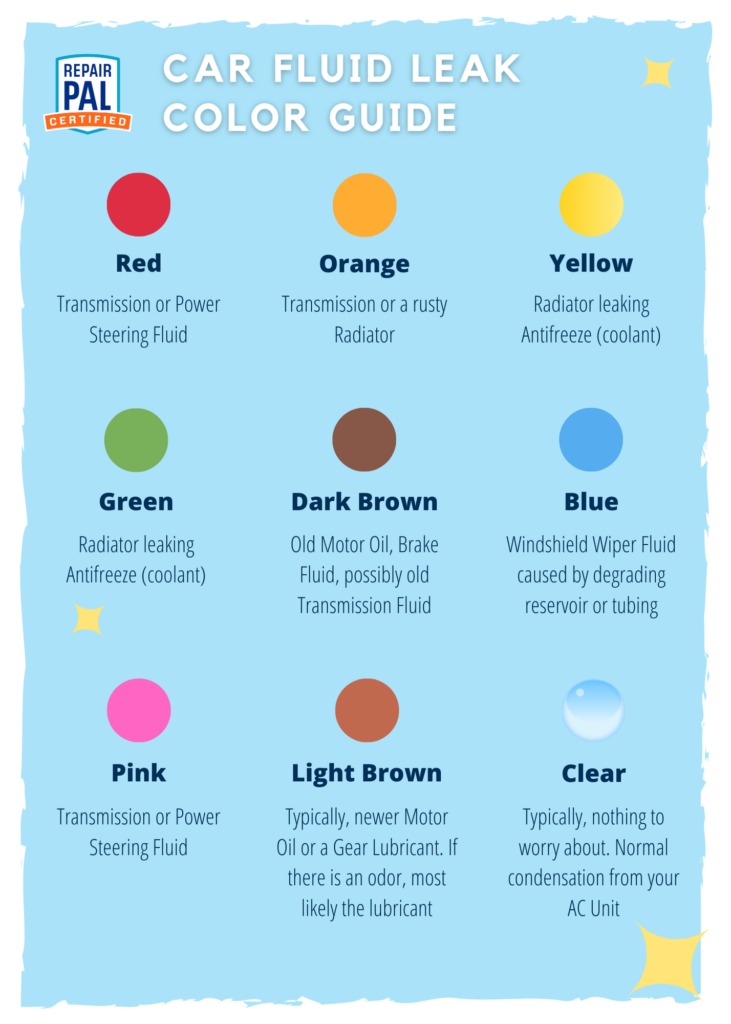When it comes to driving, safety is our top priority, and one of the most important systems in our vehicles is the braking system.
And, knowing how to identify issues like brake fluid leaks can help keep you and others safe on the road.
In this guide, we’ll cover:
- What brake fluid leaks are
- How to recognize their colors
- Why they can be dangerous
And how to check for them.
What Color Is Brake Fluid Leak?
When you notice a fluid leak under your vehicle, it’s important to identify it, especially if it’s brake fluid.

The color of the brake fluid can tell you a lot about its condition and whether you need to take action.
Fresh brake fluid typically starts as a light yellow or amber color.
If you see this color, your brake fluid is in good shape, and there’s no immediate concern.
However, the brake fluid can darken as time passes due to moisture absorption and contamination.
If you observe a dark yellow or brown puddle, this indicates that your brake fluid is starting to absorb moisture.
Moisture in brake fluid can lower its boiling point, which may lead to reduced braking performance, especially during heavy use.
This is a sign that you should consider flushing and replacing the brake fluid soon to maintain optimal performance.
A more serious issue arises when the brake fluid appears dark brown or even black.
This color change signifies that the fluid is severely degraded and contaminated.
Driving with this type of brake fluid can lead to corrosion within your braking system, which could result in brake failure.
And, If you’re unsure about what the leak looks like or how to handle it, remember that any slippery-feeling fluid under your car is likely brake fluid.
Read Also: What Color Should My Brake Fluid Be? (Normal Vs. Contaminated)
Is Brake Fluid Leak Dangerous?
A brake fluid leak can be very dangerous, take it seriously.
When your vehicle has a brake fluid leak, it can lead to a significant drop in brake performance.
This means that when you press the brake pedal, your car may not stop as quickly or effectively as it should.
However, If you notice that your brakes feel soft or spongy, this could be a sign of low brake fluid levels due to a leak.
Ignoring this problem can put you and others on the road at risk.
Imagine driving down the highway and suddenly realizing that your brakes aren’t responding properly.
This situation can happen if you overlook signs of a brake fluid leak.
You might see a yellowish or brown puddle under your car, which is a clear indicator that something is wrong with your braking system.
Additionally, if the brake fluid warning light on your dashboard comes on, act immediately.

This light is there for a reason, it alerts you to potential issues with your brakes.
The consequences of a brake fluid leak can be severe.
If the leak continues, you could lose all braking power, leading to dangerous situations and possible accidents.
A complete failure of the hydraulic brake system can occur if the leak is not fixed promptly.
So, It’s essential to check for any signs of a brake fluid leak regularly and address them quickly.
If you suspect that you have a brake fluid leak, don’t hesitate to consult with a professional mechanic.
They can help diagnose the issue and recommend necessary repairs.
Read Also: Leaking Brake Fluid Cost Repair
How To Check For Brake Fluid Leak?
To check for a brake fluid leak in your car, follow these simple steps:
Step 1: Park Safely
Start by parking your car on a flat surface.
Turn off the engine and make sure the car is in gear or parked.
This will keep the vehicle stable while you inspect it.
Step 2: Look for Puddles
Check the ground under your car for any signs of fluid leaks.
If you see a yellowish or brown puddle, it could be brake fluid.
As we’ve said, Fresh brake fluid is usually light yellow, while older fluid can appear dark brown.
If you find a puddle, this is a clear sign that there may be a brake fluid leak.
Step 3: Inspect the Brake Fluid Reservoir
Open the hood and locate the brake fluid reservoir.

It’s near the back of the engine bay and has a clear plastic container with markings on the side.
Check the fluid level against these markings.
If it’s low or below the minimum line, this could indicate a leak somewhere in your braking system.
Step 4: Examine Brake Lines and Hoses
Take a close look at the brake lines and hoses that run from the master cylinder to each wheel.
Look for any signs of wear, cracks, or wet spots that might suggest a leak.
If you see any corrosion or damage, this could be a source of your problem.
Step 5: Check Around the Master Cylinder
Inspect the area around the master cylinder for any signs of leaking fluid.
This component is essential for your hydraulic brake system, and leaks here can lead to serious issues.
Step 6: Test Brake Pedal Feel
Press down on the brake pedal.
If it feels soft or goes all the way to the floor without much resistance, this could indicate low brake fluid levels due to a leak.
A spongy feeling is often a sign that air has entered the brake lines.
If you notice any signs of a brake fluid leak during your inspection, do not ignore them.
Make sure to consult with a professional mechanic as soon as possible.
Related Post:
Does Brake Fluid Leak When The Car Is Off?
5 Brake Fluid Leak Symptoms
Brake Fluid Low But No Leak
